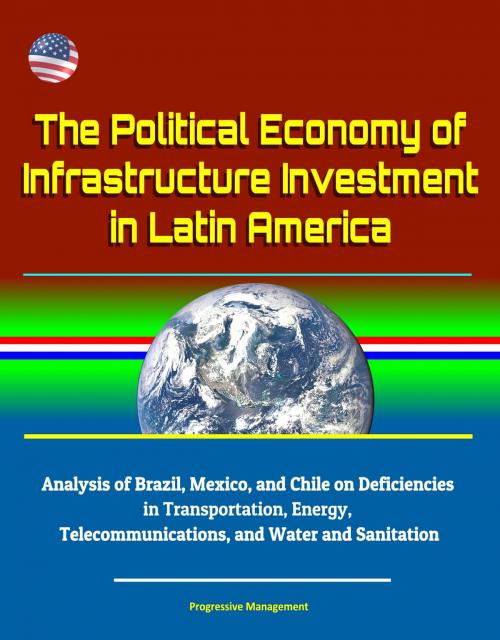The Political Economy of Infrastructure Investment in Latin America: Analysis of Brazil, Mexico, and Chile on Deficiencies in Transportation, Energy, Telecommunications, and Water and Sanitation
Business & Finance, Business Reference, Infrastructure, Nonfiction, History, Americas, Latin America| Author: | Progressive Management | ISBN: | 9780463986363 |
| Publisher: | Progressive Management | Publication: | June 12, 2018 |
| Imprint: | Smashwords Edition | Language: | English |
| Author: | Progressive Management |
| ISBN: | 9780463986363 |
| Publisher: | Progressive Management |
| Publication: | June 12, 2018 |
| Imprint: | Smashwords Edition |
| Language: | English |
This important 2018 report has been professionally converted for accurate flowing-text e-book format reproduction.
What factors are responsible for varying levels of infrastructure investment and development across Latin America? Deficiencies in economic infrastructure—broadly classified into four main sectors: transportation, energy, telecommunications, and water and sanitation—have been a principal factor limiting economic growth, slowing development, and increasing inequality in Latin America. In this thesis, I examine how formal and informal political institutions affect economic policy and the actions of politicians to determine the degree of infrastructure investment and development in Brazil. My research indicates that despite above average investment levels, Brazil's relatively low infrastructure development stems from its degree of political and fiscal decentralization combined with an electoral system that promotes clientelistic networks, reducing the effectiveness and efficiency of investments. Though Brazil displays some geographic and cross-sector variation, a preliminary examination of Mexico and Chile supports the central role that institutions play in infrastructure investment and development across the region. Moreover, my combined analysis of these three cases suggests it is not simply the shape of institutions, but also the manner in which they evolve, that prove instrumental in determining a country's level of infrastructure development and the strategies by which it can improve.
I. INFRASTRUCTURE IN LATIN AMERICA * A. INTRODUCTION * B. LITERATURE REVIEW * C. HYPOTHESIS * D. RESEARCH DESIGN AND OVERVIEW * 1. Scope * 2. Analysis and Case Selection * 3. Sources and Definitions * II. BRAZIL'S INFRASTRUCTURE TRENDS IN CONTEXT * A. BOTTLENECKS * B. QUALITY, QUANTITY, AND ACCESS * C. INVESTMENT LEVELS * III. BRAZIL'S INSTITUTIONAL EFFECTS * A. POLITICAL AND FISCAL DECENTRALIZATION * B. THE ELECTORAL SYSTEM * C. INFORMAL INSTITUTIONS: ELECTORAL MARKETS * IV. BRAZIL'S POLICIES AND POLITICIANS * A. PROCYCLICALITY * B. ELECTORAL CYCLES * C. LEADERS, IDEOLOGY, AND PRIVATIZATION * V. CONCLUSIONS * A. OBSERVATIONS * B. ADDITIONAL CASES * 1. Mexico * 2. Chile * C. ANALYSIS * D. RECOMMENDATIONS * E. FUTURE RESEARCH * APPENDIX A. ADDITIONAL FIGURES * A. LAC-6. * B. ARGENTINA * C. COLOMBIA * D. PERU
This important 2018 report has been professionally converted for accurate flowing-text e-book format reproduction.
What factors are responsible for varying levels of infrastructure investment and development across Latin America? Deficiencies in economic infrastructure—broadly classified into four main sectors: transportation, energy, telecommunications, and water and sanitation—have been a principal factor limiting economic growth, slowing development, and increasing inequality in Latin America. In this thesis, I examine how formal and informal political institutions affect economic policy and the actions of politicians to determine the degree of infrastructure investment and development in Brazil. My research indicates that despite above average investment levels, Brazil's relatively low infrastructure development stems from its degree of political and fiscal decentralization combined with an electoral system that promotes clientelistic networks, reducing the effectiveness and efficiency of investments. Though Brazil displays some geographic and cross-sector variation, a preliminary examination of Mexico and Chile supports the central role that institutions play in infrastructure investment and development across the region. Moreover, my combined analysis of these three cases suggests it is not simply the shape of institutions, but also the manner in which they evolve, that prove instrumental in determining a country's level of infrastructure development and the strategies by which it can improve.
I. INFRASTRUCTURE IN LATIN AMERICA * A. INTRODUCTION * B. LITERATURE REVIEW * C. HYPOTHESIS * D. RESEARCH DESIGN AND OVERVIEW * 1. Scope * 2. Analysis and Case Selection * 3. Sources and Definitions * II. BRAZIL'S INFRASTRUCTURE TRENDS IN CONTEXT * A. BOTTLENECKS * B. QUALITY, QUANTITY, AND ACCESS * C. INVESTMENT LEVELS * III. BRAZIL'S INSTITUTIONAL EFFECTS * A. POLITICAL AND FISCAL DECENTRALIZATION * B. THE ELECTORAL SYSTEM * C. INFORMAL INSTITUTIONS: ELECTORAL MARKETS * IV. BRAZIL'S POLICIES AND POLITICIANS * A. PROCYCLICALITY * B. ELECTORAL CYCLES * C. LEADERS, IDEOLOGY, AND PRIVATIZATION * V. CONCLUSIONS * A. OBSERVATIONS * B. ADDITIONAL CASES * 1. Mexico * 2. Chile * C. ANALYSIS * D. RECOMMENDATIONS * E. FUTURE RESEARCH * APPENDIX A. ADDITIONAL FIGURES * A. LAC-6. * B. ARGENTINA * C. COLOMBIA * D. PERU















